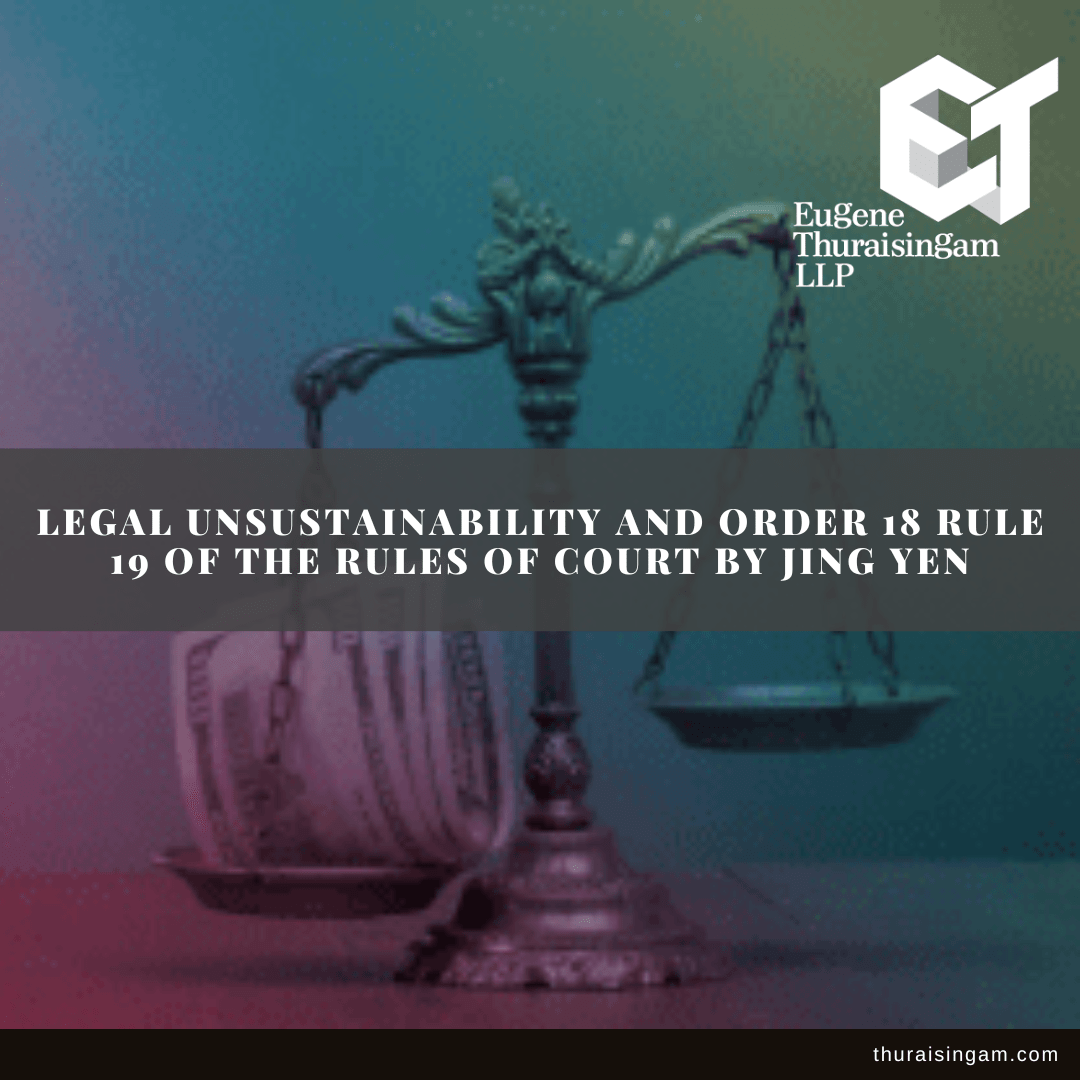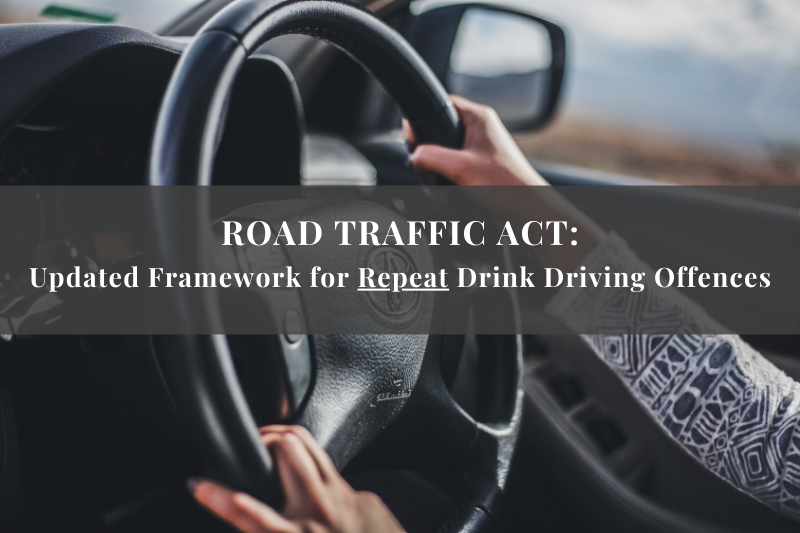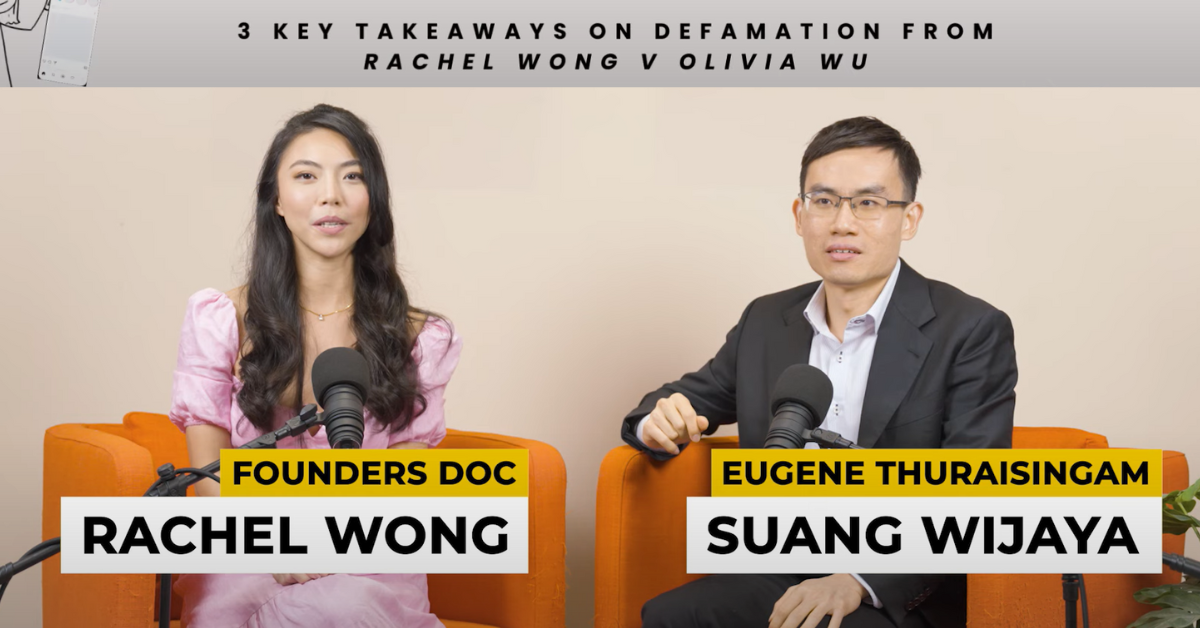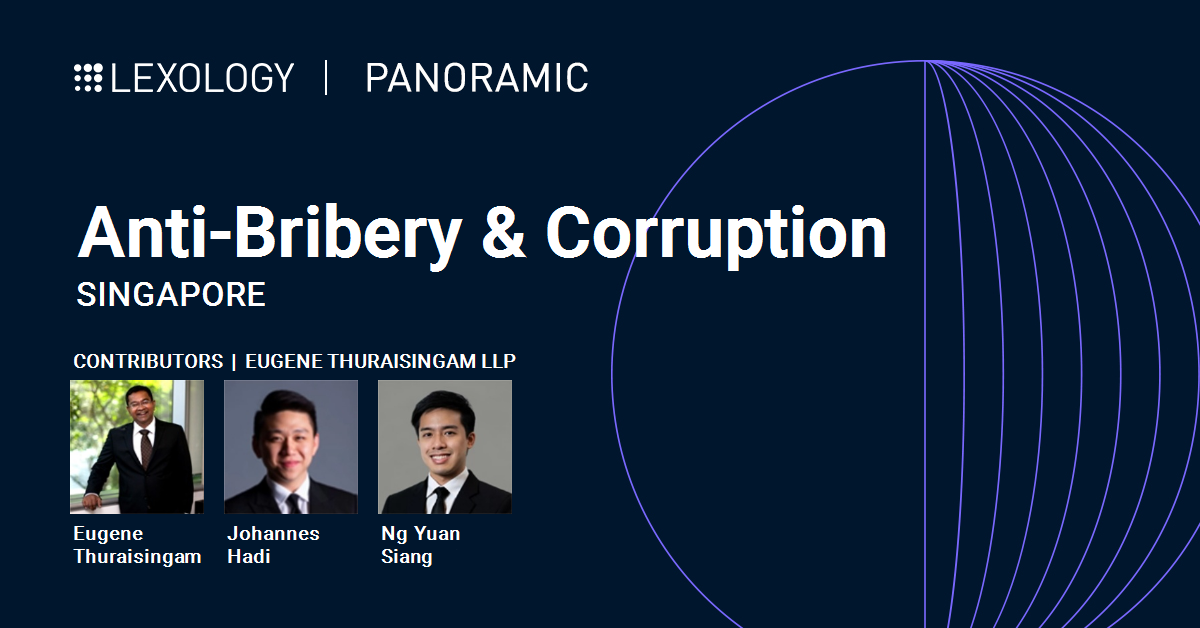Legal Unsustainability and Order 18 Rule 19 of the Rules of Court
Legal Unsustainability and Order 18 Rule 19 of the Rules of Court by Chooi Jing Yen*
The decision of the High Court in Qroi Ltd v Pascoe, Ian and another [2019] SGHC 36 (Qroi), though short, was impactful. This article unpacks its significance and comes to the conclusion that the English Premier League really does not have much to do with the law on striking out frivolous or vexatious claims. In particular, the twin requirements of legal and factual sustainability continue to circumscribe and restrict such actions from reaching the Courts.
The facts and procedural history in Qroi Ltd v Pascoe, Ian and another [2019] SGHC 36 (Qroi) may be distilled thus:
- Company A sues Company B for non-payment of services delivered pursuant to an Agreement. At the same time, Company A sues Individual C for breach of warranty of authority, alleging that he had represented that he was acting on behalf of Company D (who is not a party to the action) when negotiating and executing the Agreement, which representation Company A says it had relied on when it had entered into the Agreement, which turned out to be with Company B. Individual C denies this and says he made no such misrepresentation.
- Company A appears to now accept that Company B is indeed the counterparty to the Agreement, since it has sued Company B for non-payment and not Company D.
- Individual C applies to strike out Company A’s action against him, relying on Order 18 rule 19(1)(a) of the Rules of Court (that the statement of claim discloses no reasonable cause of action) and Order 18 rule 19(1)(b) of the Rules of Court (that the action is frivolous and vexatious).
- One of Individual C’s arguments is that since he has authority to act for both Company B and Company D (as well as five other companies bearing a similar brand name), Company A has no cause of action for breach of warranty of authority because it has failed to identify in its statement of claim any entity for which Individual C has no authority to act.
The existing body of case law appears to support Individual C’s proposition.
The High Court nevertheless declined to grant the application. It said:1
… even if the law is presently on his [Individual C’s] side so far as the proper parties’ issue is concerned, the plaintiff is entitled to challenge that law or the application of it. So long as the court may still disagree with current judicial thinking, the plaintiff is entitled to have his action proceeded. The principle here is simple – if Newcastle United can beat Manchester City in the English Premier League, anything can happen.
There is much to unpack from this short pronouncement.
The ability to strike out early a frivolous action lacking in factual or legal basis has long been afforded to defendants through Order 18 rule 19(1) of the Rules of Court. Litigation is a long process, and trials are expensive. A defendant should rightly not be compelled to have to defend an obviously unmeritorious action.2
But perched at the other end of the see-saw is the notion of access to justice. Striking out an action is a draconian order which completely shuts a plaintiff out from the courts without affording him any opportunity to present his case, however weak. Thus, the courts have said that they will not do so unless it is plain and obvious that it is impossible for the case to succeed. A plaintiff pays for bringing a weak (but not hopeless) case to court by having to pay a portion of the defendant’s costs if he loses.3 Many a defendant has derived scant consolation from this – having lost time and the other portion of the costs.
When is an Action Plainly or Obviously Unsustainable?
The Court of Appeal in The “Bunga Melati 5” [2012] 4 SLR 546 (The Bunga Melati 5) explained that there are two ways in which an action may be plainly or obviously unsustainable:4
- an action is legally unsustainable where it is clear as a matter of law at the outset that even if the plaintiff were to succeed in proving all the facts that he offers to prove, he will still not be entitled to the remedy that he seeks; or
- an action is factually unsustainable where it is possible to say with confidence before trial that the factual basis for the claim is fanciful because it is entirely without substance, for example, where the statement of facts is contradicted by all the documents or other material on which it is based.
In practice, it is not easy to persuade a court that an action is factually unsustainable. This is an evidential issue, and it is not within the court’s remit at the interlocutory stage of the proceedings to conduct a “minute and protracted” examination of the documents.5 So long as it is not plain and obvious on the face of the documents (or other evidence) that the facts asserted by the plaintiff are entirely fanciful, the court has to decline to strike out the action. The default position is that all facts asserted by a plaintiff in the statement of claim are presumed true for the purposes of a striking out application.
The facts pleaded must nevertheless disclose a legal cause of action. Otherwise, the action will fail the test of legal sustainability.
Putting these rules together, the result is that a plaintiff who intends to vex and oppress can defeat a striking out application by simply pleading facts which he knows to be untrue, or does not know whether are true, since this will only be exposed at the trial but which nevertheless if true and proven would disclose a legal cause of action. The defendant would therefore not be availed of the remedy of early termination by striking out.
The test of legal sustainability thus stands as a bastion between frivolous actions and a trial. This is where the significance of the pronouncement in Qroi lies.
We know from The Bunga Melati 5 that an action is legally unsustainable where it is “clear beyond question that certain legal elements of a plaintiff’s claim based on its pleadings cannot be satisfied, or if there is an obvious legal defence or principle in existence which will have defeated the plaintiff’s claim even if all the facts alleged by the plaintiff are proved.”6
One obvious situation to which this would apply is where the cause of action pleaded by the plaintiff does not exist. This may either be because our courts have not ever recognised the same, or have already expressly rejected the same.
An example of the former is the “tort of market manipulation”. This was pleaded by the plaintiff in TMT Asia Ltd v BHP Billiton Marketing AG (Singapore Branch) and another [2015] 2 SLR 540 (TMT Asia) and thrown out at the interlocutory stage of the proceedings by the High Court for having received no “judicial endorsement … from any quarter.”7
An example of the latter is the applicability of the tort of malicious prosecution to civil proceedings, which was unequivocally rejected by a five-member Court of Appeal in Lee Tat Development Pte Ltd v Management Corporation Strata Title Plan No 301 [2018] 2 SLR 866 (Lee Tat).8 For much of the same reasons, the Court of Appeal in Lee Tat also rejected the tort of abuse of process.9 Lee Tat did not, however, concern a striking out application but was decided after a full trial and submissions on whether both torts should be recognised in Singapore.
Approximately two months after its decision in Lee Tat, the Court of Appeal had the opportunity to briefly revisit the issue in Sunbreeze Group Investments Ltd and others v Sim Chye Hock Ron [2018] 2 SLR 1242 (Sunbreeze). The third party in Sunbreeze had applied to strike out the proceedings instituted against him by the defendants on a number of grounds. The Court of Appeal affirmed its holding in Lee Tat that the tort of abuse of process did not exist in Singapore.10
Notwithstanding the above, the defendant in Lee Hsien Loong v Leong Sze Hian [2019] SGHC 66 (LHL v LSH), who was being sued for defamation, pleaded a counterclaim in the tort of abuse of process. Upon being challenged by the plaintiff’s striking application, the defendant sought to persuade the High Court to carve out an exception where there is an (alleged) abuse of a public function.11 This was rejected. The High Court judge said:
I am satisfied that the Court of Appeal’s decision in Lee Tat is binding on me and that the doctrine of stare decisis applies. Lee Tat precludes the defendant’s counterclaim from succeeding. The Court of Appeal was emphatic at [161] that the tort of abuse of process is not recognised in Singapore law.
The defendant’s cross-application to strike out the plaintiff’s action was dismissed. The tort of defamation is, after all, well-established in Singapore jurisprudence.
Qroi was briefly mentioned in LHL v LSH, but not analysed. All that was said was that it does not change the law on striking out.12 The paragraph quoted above was not cited.
Given the principles of stare decisis, what does it mean to say that an action should not be struck out for legal unsustainability so long as “the court may still disagree with current judicial thinking”? The High Court is not bound by its own prior decisions, and neither is the Court of Appeal. On a plain reading taken to its logical conclusion, this would render the test of legal sustainability obsolete and the striking out remedy potentially toothless:
- A determinedly malicious plaintiff may plead facts disclosing no recognised cause of action, or one that has been previously rejected by the courts.13
- Purely based on Qroi, he would escape the test of legal unsustainability by arguing that it is theoretically possible (on principles of stare decisis) that at some point in the future, the courts may recognise his proposed cause of action, or reverse their prior rejection of the same.
- He need not concern himself with factual unsustainability, since the ease with which he would be able to overcome the hurdle of legal unsustainability would render it unnecessary for him to plead untrue facts.
The above is an illustration that the tests of factual and legal sustainability need necessarily go hand in hand, and that to injure one would be to cripple the whole.
It therefore could not have been the holding in Qroi that a plaintiff is entitled to proceed with his action so long as he strives to, at the close of trial, persuade the court to “disagree with current judicial thinking” and endorse his proposed cause of action. Circling back to the arguments in Qroi, the proposition being advanced was that the plaintiff had no cause of action for breach of warranty of authority because it had failed to identify in its statement of claim any entity for which the first defendant had no authority to act. The essential submission was that “this is not a dispute about authority but a dispute about the proper party to the [Agreement].”14 If so, then the challenge was not that the plaintiff’s claim was legally unsustainable (since breach of warranty of authority is clearly a recognised cause of action) but that it was factually unsustainable.
Qroi therefore does not modify the requirement of legal sustainability in any way, and must be confined to its facts. The allusion to the football fan’s romanticism that “anything can happen” must not be overstated. Though horizontal stare decisis does not prevail in Singapore, the Honourable Justice Quentin Loh in Attorney-General v Shadrake Alan [2011] 2 SLR 445 nevertheless cautioned that:15
I must bear in mind that the decisions of my learned colleagues and predecessors over the past four decades are entitled to the very greatest respect and unless there are compelling reasons to do so, I should not depart from them.
Indeed, coming after Qroi, the High Court in Bae Junho v Daimwood, Samuel Lathan & Anor [2019] SGHCR 9 did strike out yet another action on the basis that the facts pleaded did not disclose a cause of action. The plaintiff was the husband of a student of the second defendant (which was a private educational institution), who had engaged in adultery with her lecturer, the first defendant.
The plaintiff’s claim against the first defendant was framed in the tort of negligence, whilst his claim against the second defendant was framed in vicarious liability. Both defendants applied, successfully, to strike out the plaintiff’s action. As the key facts were not in dispute, the decision turned on whether the plaintiff’s claim against the first defendant was legally sustainable.
The High Court noted that the plaintiff had couched his claim under the tort of negligence precisely because he knew that the tort of enticement was not a valid cause of action in Singapore.16 This was in light of the decision in TPY v DZI [1997] 1 SLR(R) 843 (TPY v DZI), where the Honourable Justice MPH Rubin had noted that the tort of enticement had been abolished in England and had “no known presence in Singapore.”17
Interestingly, MPH Rubin J had struck out the action in TPY v DZI even though there had been no prior judicial pronouncement as to whether the tort of enticement should be recognised in Singapore, and even though the same had in fact been received by Singapore through the Second Charter of Justice.18 If one were to read Qroi literally, an argument could be made that he should not have done so.
In sum, we now know at the least that the following causes of action do not exist in Singapore and any attempt to plead the same would be liable to be struck out on the ground of legal unsustainability:19
- the tort of market manipulation (TMT Asia);
- the tort of abuse of process (Lee Tat); and
- the tort of enticement (TPY v DZI).
Ultimately, the law on striking out needs to achieve a delicate balance between allowing claimants to have their day in court and sparing defendants from having to defend frivolous proceedings. To tilt the scales too far in one or the other direction would have the effect of either stifling litigation and potentially impeding the development of local jurisprudence, or clogging up the courts with wasteful litigation. Where the balance should fall at any given point in time must surely depend on the prevailing (judicial or parliamentary) attitude towards this.
For example if at some point in the future a rule is instituted that litigants should be entitled to recover the full amount of their legal costs against their opponents if they are ultimately successful, then the argument could be made that there should be less scrutiny on the factual and legal sustainability of the claim at the interlocutory stage of the proceedings. Presumably, this greater liability would deter frivolous litigants, whilst at the same time obviating to a large extent the costs concerns imposed upon hapless defendants.
Equally, if the courts start to become inundated with such a large volume of cases that they cannot cope, then perhaps it would be appropriate to take a more robust approach. After all, justice delayed is justice denied, and time should not be spent dealing with unmeritorious matters at the expense of meritorious ones. The striking out regime is an important weapon in the arsenal of a defendant who, in the words of MPH Rubin J, seeks to guard against “fruitless litigation for vindictive purposes.”20
*”Legal Unsustainability and Order 18 Rule 19 of the Rules of Court” was the feature article in the September 2019 edition of the Law Gazette.
Footnotes
- Qroi Ltd v Pascoe, Ian and another (2019) SGHC 36 at (4).
- Kim Hok Yung v Cooperatieve Centrale Raiffeisen-Boerenleenbank BA (2000) 2 SLR(R) 455 (SGHC) at (17).
- Kim Hok Yung v Cooperatieve Centrale Raiffeisen-Boerenleenbank BA (2000) 2 SLR(R) 455 (SGHC) at (17).
- The “Bunga Melati 5” (2012) 4 SLR 546 (SGCA) at (39).
- Gabriel Peter & Partners v Wee Chong Jin (1997) 3 SLR(R) 649 (SGCA) at (18).
- The “Bunga Melati 5” (2012) 4 SLR 546 (SGCA) at (75).
- TMT Asia Ltd v BHP Billiton Marketing AG (Singapore Branch) and another (2015) 2 SLR 540 (SGHC) at (55).
- Lee Tat Development Pte Ltd v Management Corporation Strata Title Plan No 301 (2018) 2 SLR 866 (SGCA) at (128).
- Lee Tat Development Pte Ltd v Management Corporation Strata Title Plan No 301 (2018) 2 SLR 866 (SGCA) at (161).
- Sunbreeze Group Investments Ltd and others v Sim Chye Hock Ron (2018) 2 SLR 1242 (SGCA) at (37)-(38).
- Lee Hsien Loong v Leong Sze Hian (2019) SGHC 66 at (22).
- Lee Hsien Loong v Leong Sze Hian (2019) SGHC 66 at (48).
- The possibility of such plaintiffs existing was alluded to in Lee Tat Development Pte Ltd v Management Corporation Strata Title Plan No 301 (2018) 2 SLR 866 (SGCA) at (122).
- Qroi Ltd v Pascoe, Ian and another (2019) SGHC 36 at (4).
- Attorney-General v Shadrake Alan (2011) 2 SLR 445 (SGHC) at (5), cited with approval in Peter Low LLC v Higgins, Danial Patrick (2018) 4 SLR 1003 (SGHC) at (134).
- Bae Junho v Daimwood, Samuel Lathan & Anor (2019) SGHCR 9 at (29).
- TPY v DZI (1997) 1 SLR(R) 843 (SGHC) at (12)-(14).
- TPY v DZI (1997) 1 SLR(R) 843 (SGHC) at (11).
- There are probably more, but these are the ones surveyed in this article.
- TPY v DZI (1997) 1 SLR(R) 843 (SGHC) at (14).






